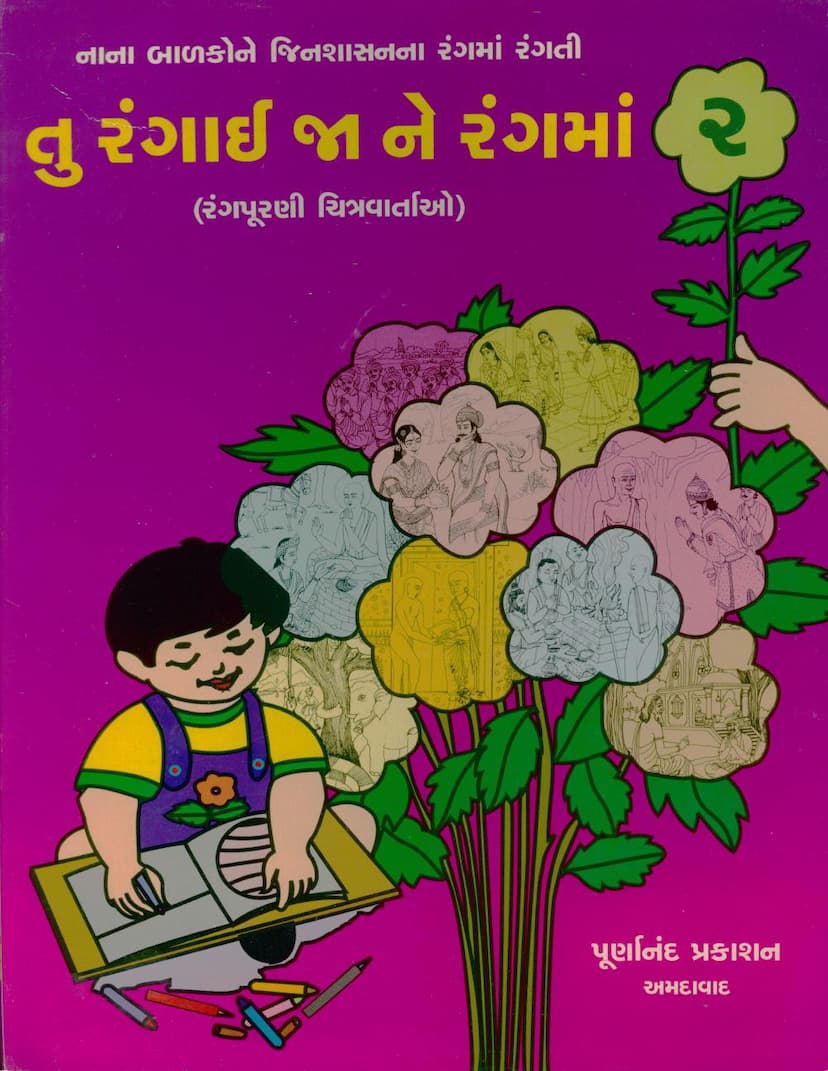Tu Rangai Jane Rangma 02
Added to library: September 2, 2025

Summary
This document is the second issue of a Gujarati Jain coloring storybook series titled "Tu Rangai Jane Rangma" (May You Be Dyed in Color) published by Purnanand Prakashan, Ahmedabad. The series aims to educate young children about Jainism through engaging stories and coloring activities.
Key elements of the document include:
-
Introduction to Issue 2: The book is presented as the second installment, encouraging children to color diligently while absorbing the stories. It advises them to use their time productively, especially after exams, rather than spending it on screens.
-
Competition Announcement: A competition is announced where children are asked to answer eight questions based on the stories within the book. Answers must be sent via postcard, with specific instructions on format (one word answers), including personal details, and the possibility of winning prizes with their names printed in the next issue. The deadline for submissions is mentioned as June 15, 2008.
-
Previous Competition Results: The correct answers to the questions from the previous issue are provided, along with the names of five lucky winners who will receive prizes.
-
Future Contest Information: A heads-up is given about a future question paper in the fourth issue that will cover questions from all four books of the year, with more prizes planned. This emphasizes the importance of saving all issues.
-
Stories Presented: The book features several illustrated stories about prominent figures in Jainism, each accompanied by a moral or lesson for children:
- Rani Rukmini: The story of Queen Rukmini, consort of Krishna, and her 16-year separation from her son, explained by Lord Neminath as a consequence of her past actions (coloring a peacock's egg with henna). The lesson emphasizes that even unintentional harm to others can lead to suffering and the importance of atonement.
- Anathi Muni: The story of King Shrenik's encounter with Anathi Muni, who renounced worldly pleasures due to his feeling of being "anathi" (without a protector) during a severe illness. The story highlights that true support comes from Dharma and God, not material possessions or relationships during times of suffering. It also leads to Shrenik's attainment of Samyakta (right faith).
- Samprati Maharaja: The story of Emperor Samprati, who, at his mother's urging, dedicated his vast wealth to building 36,000 new Jain temples and renovating 89,000 more, thereby creating over 1.25 lakh temples and installing 1.25 crore idols. He also established 700 charity centers. The lessons include the ephemeral nature of wealth, the importance of filial piety, and the virtue of appreciating and supporting religious endeavors.
- Chandanbala: The story of Chandanbala, a princess who was captured, sold as a slave, and subjected to hardship and humiliation, yet maintained her inner purity and devotion. Her act of offering alms to Lord Mahavir under specific adverse conditions fulfilled his vow and brought about miraculous events. The lesson emphasizes that one's virtues make them beloved, the importance of maintaining equanimity during adversity, and the ultimate victory of truth.
- Upakari Sant (Benevolent Saint): A story about a saint who patiently endured insults and abuse from villagers without retaliation. When questioned, he explained that insults, if not accepted, return to the giver. The moral is not to get angry when provoked and to consider those who cause suffering as "benevolent" for helping to shed karmas.
- Dhanna Kakandi: The story of Dhanna Kumara, who, after experiencing worldly pleasures, renounced them to become a monk. He practiced severe austerities, earning the title of the best ascetic among Lord Mahavir's disciples. The lesson is that wealth cannot grant liberation, and renunciation is key to spiritual progress.
- Shayambhav Suri: The story of Acharya Shayambhav Suri, who, despite being a staunch Brahmin practicing animal sacrifices, was guided by Jain monks to the true meaning of sacrifice (of one's own faults and negative thoughts). He eventually took Jain initiation, became a scholar, and compiled the Dashavaikalika Sutra. The lessons are the importance of faith in spiritual guides and the willingness to correct one's errors when enlightened.
- Madhubindu (Drop of Honey): This is an allegorical story illustrating the perils of worldly attachments (desires). A man escaping a wild elephant climbs a tree, only to find mice (representing day and night) gnawing at the branch. Below him is a well with snakes (representing fears), and the elephant shakes the tree, disturbing a beehive, causing stings (representing worldly troubles). Despite the imminent dangers, he is tempted by a drop of honey falling from the hive, delaying his escape. The story teaches that worldly desires are like honey drops, distracting from the critical need to escape the cycle of suffering and the dangers of life.
-
Publisher Information: Contact details for Purnanand Prakashan, including an address and mobile number, are provided.
-
Call for Participation: An invitation is extended to children to send their photographs for publication in the next issue for a fee, promoting further engagement.
In essence, "Tu Rangai Jane Rangma 02" is a vibrant and educational resource designed to instill Jain values and stories in young minds through the interactive medium of coloring and storytelling, coupled with engaging competitions.